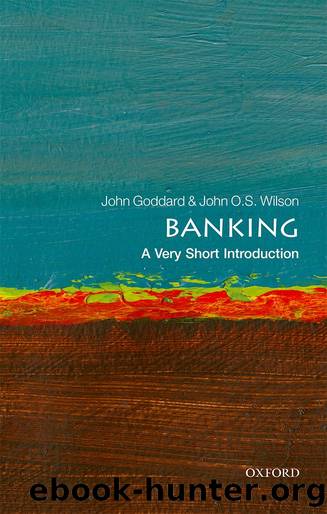Banking by John Goddard & John O. S. Wilson

Author:John Goddard & John O. S. Wilson [Goddard, John & Wilson, John O. S.]
Language: eng
Format: epub
ISBN: 9780191002816
Publisher: OUP Oxford
Published: 2016-10-03T00:00:00+00:00
Basel I was simple to understand, transparent, and provided incentives for banks to hold highly liquid, low-risk assets. Almost all countries with developed banking systems transposed Basel I into national law. However, Basel I focused solely on the credit risk associated with lending, and ignored other sources of risk. Subsequently amendments required banks to hold capital against market risk. Banks were encouraged to use internal risk-assessment models to measure their exposure to market risk, dependent on the composition of their assets portfolios.
Basel II, launched in 2006, established a three-pillar framework comprising minimum capital requirements (Pillar 1); supervisory review (Pillar 2); and market discipline (Pillar 3). For Pillar 1, the definition of capital remained unchanged, but the risk-weightings reflected credit, market, and operational risk. The calculations relied heavily on the banksâ own internal risk measurement models, and on ratings provided by credit-rating agencies such as Standard & Poorâs, Moodyâs, and Fitch IBCA. Pillar 2 required national supervisors to review the capital adequacy provisions of each bank. Supervisors have the discretion to require banks to hold capital above the minimum regulatory requirements. Pillar 3 requires banks to disclose information regarding risk exposures, capital adequacy, and other material details. It was intended that greater reliance should be placed on market discipline as a constraint on risk-taking behaviour. Forward-looking market-based information embodied in banksâ share and bond prices and ratings can inform supervision, and provide early warning of the need for supervisory intervention.
Basel II was never fully implemented, owing to the onset of the global financial crisis, which exposed weaknesses in capital regulation. Risk-based capital ratios were supposedly superior measures of capital adequacy; but their usefulness was dependent on the accurate measurement of risk. The financial crisis damaged the credibility of the banksâ internal models for risk measurement, damaged the reputations of the credit-rating agencies, and raised doubts about the effectiveness of market discipline as a constraint on risk-taking. Furthermore, Basel II may have amplified the business cycle because it is pro-cyclical. During buoyant economic conditions, risk is perceived to be low and lending tends to increase. Banks extend what ultimately turn out to be poor-quality loans, without accumulating sufficient capital. During a recession, conversely, loan delinquencies deplete capital, while a mood of pessimism suggests capital should be increased. Banks hold insufficient capital to absorb losses, and scramble to improve their capital ratios by reducing lending, leading to credit rationing. Changes to international capital regulation since the global financial crisis are described in Chapter 8.
Download
This site does not store any files on its server. We only index and link to content provided by other sites. Please contact the content providers to delete copyright contents if any and email us, we'll remove relevant links or contents immediately.
The Black Swan by Nassim Nicholas Taleb(6191)
Bad Blood by John Carreyrou(5769)
Pioneering Portfolio Management by David F. Swensen(5606)
Millionaire: The Philanderer, Gambler, and Duelist Who Invented Modern Finance by Janet Gleeson(3569)
Skin in the Game by Nassim Nicholas Taleb(3460)
The Money Culture by Michael Lewis(3284)
Skin in the Game: Hidden Asymmetries in Daily Life by Nassim Nicholas Taleb(3264)
Bullshit Jobs by David Graeber(3180)
The Wisdom of Finance by Mihir Desai(3079)
Blockchain Basics by Daniel Drescher(2891)
Liar's Poker by Michael Lewis(2812)
The Intelligent Investor by Benjamin Graham Jason Zweig(2596)
Hands-On Machine Learning for Algorithmic Trading by Stefan Jansen(2518)
Mastering Bitcoin: Programming the Open Blockchain by Andreas M. Antonopoulos(2511)
Investing For Dummies by Eric Tyson(2470)
Fooled by Randomness: The Hidden Role of Chance in Life and in the Markets by Nassim Nicholas Taleb(2413)
The Power of Broke by Daymond John(2376)
Zero Hour by Harry S. Dent Jr. & Andrew Pancholi(2246)
Market Wizards by Jack D. Schwager(2163)
